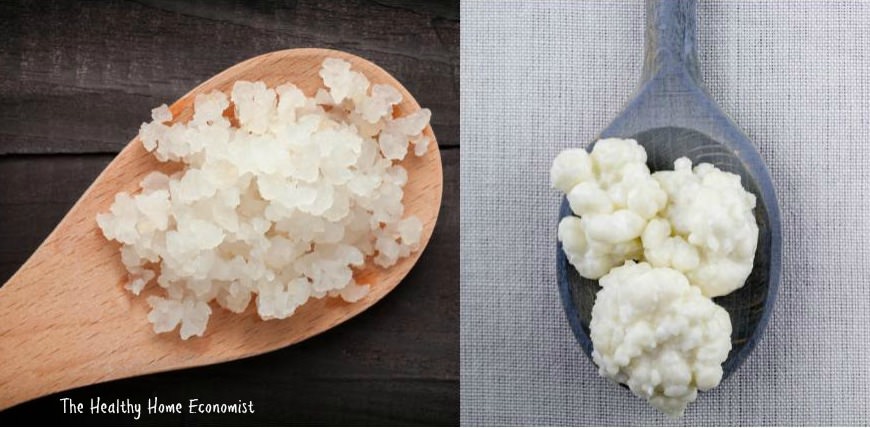Table of Contents[Hide][Show]

There are two ways to make kefir. First, you can make homemade milk kefir from dairy milk. You can also use the same type of culture to make coconut milk kefir at home.
The other type of live kefir culture is used to make water kefir and kefir sodas.
Unfortunately, folks new to traditional cooking sometimes get live water kefir and milk kefir grains confused. They might even attempt to use a milk kefir culture to make water kefir and vice versa. Not only do the live grains look and behave differently, but the beneficial microbes they impart to the fermented food or drink are quite different as well. For example, milk grains ferment in about 24 hours. A water kefir culture takes at least 2 and sometimes up to 5 days until the beverage is ready to drink.
No surprise when the fermentation doesn’t take or mold on the cultured food occurs with this type of mix-up. If you got some live grains from a friend and they didn’t seem to work very well, there is a chance that you might be using the wrong type of culture. If you aren’t sure, you can always buy instead.
Live grains for water kefir are available here and live grains for milk kefir are available here.
The Best Kefir
Note that live kefir grains are better than powdered starter. The dried powder contains less than 10 beneficial strains and no beneficial yeasts. The same goes for commercial kefir, by the way!
Live kefir grains, on the other hand, contain dozens of strains as well as beneficial yeasts to fight candida overgrowth.
In the video below, I show you the two types of kefir grains so that you know visually how to identify one versus the other.
Do you know the difference between milk kefir grains and water kefir grains? See the video below for clues!








Hello,
I would love to see the milk kefir video but it does not seem to be available. Did you remove it?
Thanks Stacey
Can water kefir grains be used to make coconut milk kefir? I bought water kefir grains to make water kefir, but the sugar is too high for my candida issues (I guess most of the sugar in coconut water kefir does not get fermented out… is this true?).
Thanks!
A few days ago I got some milk kefir grains from a friend who was using store 2% milk. I put raw milk in mine (shaken) and the result was a thin, clumpy kefir. It tasted fine, but the texture was disturbing to my kids (so I put in smoothies). I would like the smooth, creamy kefir I got at the store!!! Her grains aren’t BRIGHT white pretty like yours! Result of the nasty store milk perhaps? Think there might be an adjustment period going from dead to raw milk?
Thank you!!
Putting them in a processor was not a good idea at all. Sounds like the grains are rather weak if the kefir was thin and not thick and creamy. Can you get grains from someone else?
Hey Sarah!
I got my milk keifer grains from a friend but they do not look like cauliflower. They looked like little rice grains. I asked my friend why they looked different and she said her mom, put them in a processor to chop them up because she had heard they work better when they are smaller….
When I did my keifer did not turn out very thick, it was pretty liquidy still. It smells yummy, like yeast bread…so maybe it worked??
I believe that I have read somewhere (maybe on Dom's website) that kefir grains are the same whether they are used for water or milk kefir. I know I gave some water kefir grains to a friend recently and she subdivided them and started to culture milk with some of them. It takes a few batches before the grains become accustomed to the milk medium. In fact, I have also found the same to be true when switching back and forth between raw milk and pasteurized. Apparently, there is always a period of adjustment whenever you start using a different milk with your grains. The batches are drinkable, but they may not have the thickness or degree of fizziness desired at first.
When the little cauliflower bunch gets bigger than say, a ping pong ball or so, you can break some off and give it away or even eat it – natural probiotic!!!
So the culture continues to grow — I didn't know that. I'm sure it's based on how often you use the culture to make kefir, but how often do you have to separate it? Does it grow gradually or rapidly? Other than make kefir or give it away, is there anything else you can do with the culture?
Hi Barbara Ann, I have never activated milk kefir grains before. I only know what they look and act like once they are activated. Sounds right, though, if the culture is looking like cottage cheese. Those little chunks will probably grow over time into the cauliflower like pieces.
I'm so glad kefir was your subject today because I've started "activating" milk kefir grains a few days ago and I'm confused about the consistency. I am doing as the instructions suggest and am only using 1 cup of raw milk per day and then straining grains out daily. Yesterday I got very little liquid strained out and the culture it's looking like cottage cheese (sort of). Do you think I'm doing it correctly? If so, how long before the grains bind to look like cauliflower?